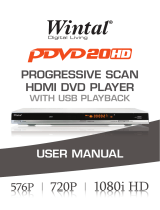
7
English
Changing subtitle language ......................................................................................................................29
Switching camera angles ............................................................................................................................29
Changing sound track language .............................................................................................................. 30
Setting the delay times for audio playback .......................................................................................... 30
Playback Control (VCD only) ................................................................................................................. 30
Playing a MP3/WMA disc ................................................................................................................................31
Playing a JPEG image le (slide show) ..........................................................................................................32
Preview function ..........................................................................................................................................32
Zoom picture ..............................................................................................................................................32
Rotating/ ipping the picture ....................................................................................................................32
Playing MP3/WMA music and JPEG pictures simultaneously ................................................................33
Playing a DivX disc .............................................................................................................................................33
Playback other supported devices
Playback - iPod ................................................................................................................34
Playing music from compatible iPod devices .................................................................................. 34
Playback - USB device ....................................................................................................35
Playing from USB ash drive or USB memory card reader....................................................................35
Playback - Other Audio Player .....................................................................................36
Playing from other portable audio player ....................................................................................................36
Setup Options
Setup Menu Options................................................................................................ 37-44
Accessing the setup menu ................................................................................................................................37
General Setup Page ........................................................................................................................................... 38
Audio Setup Page ................................................................................................................................................39
Video Setup Page .........................................................................................................................................40-42
Preference Setup Page ...............................................................................................................................43-44
Radio Tuning
Radio Operations ...................................................................................................... 45-46
Tuning to radio stations ................................................................................................................................... 45
Changing tuning grid ......................................................................................................................................... 45
Presetting radio stations ................................................................................................................................ 45
Using auto install ..................................................................................................................................45-46
Using automatic preset ............................................................................................................................. 46
Using manual preset .................................................................................................................................. 46
Selecting a preset radio station ..................................................................................................................... 46
Deleting a preset radio station ...................................................................................................................... 46
Others
Sound and Volume Controls ......................................................................................... 47
Volume control ...................................................................................................................................................47
Adjusting the Bass/ Treble level .....................................................................................................................47
Selecting surround sound .................................................................................................................................47
Selecting digital sound effects .........................................................................................................................47
Other Features................................................................................................................48
Software upgrades ............................................................................................................................................ 48
Troubleshooting .........................................................................................................49-51
Frequently Asked Questions (USB) ............................................................................. 52
Speci cations ..................................................................................................................53
Glossary...................................................................................................................... 54-55
Table of contents





















